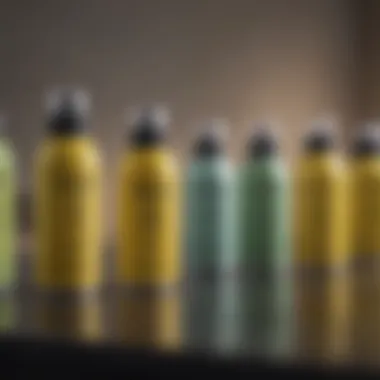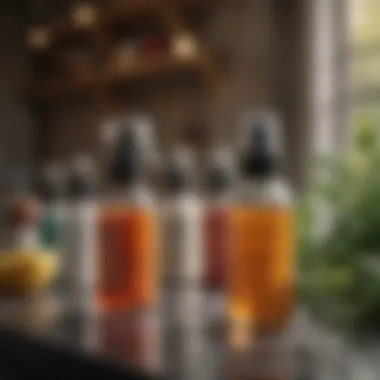Comprehensive Guide to Using Spray for Gnats Control


Intro
Gnats can be a significant nuisance for both indoor and outdoor living spaces. Homeowners and gardening enthusiasts often face challenges when it comes to managing these small flying insects. This article aims to provide a thorough exploration of sprays specifically designed to combat gnats. Understanding their types, active ingredients, application methods, and safety precautions will empower individuals to make informed pest management decisions.
The prevalence of gnats, especially during warmer months, requires effective strategies for control. This guide not only highlights the most suitable gnat sprays but also discusses their ecological implications, helping readers balance effective pest management with environmental preservation. As we navigate through this comprehensive guide, readers will gain insights into best practices for using gnat sprays effectively.
Types of Gnat Sprays
When dealing with gnats, it's crucial to choose the right spray for your specific needs. There are various types available on the market, each formulated for different scenarios:
- Insecticide Sprays: These often contain powerful chemicals to kill adult gnats. Popular choices include those with active ingredients like pyrethrins and neonicotinoids.
- Essential Oil Sprays: Made from natural extracts, these sprays are typically less harmful to the environment. Common ingredients include peppermint and citronella oil, which also offer pleasant scents.
- Biological Control Sprays: These contain beneficial organisms that target gnat larvae, disrupting their development. Bacillus thuringiensis is a well-known example.
Each of these types has its place. Residential areas might benefit from insecticide sprays for immediate relief, while gardens could see better results with essential oil or biological controls to ensure safety for plants and beneficial insects.
Active Ingredients
Understanding the active ingredients in gnat sprays is vital for effective use. Popular ingredients include:
- Pyrethrins: Derived from chrysanthemum flowers, these are effective against many types of insects but can be harmful to beneficial species.
- Neonicotinoids: These affect the nervous system of insects. While effective, they have raised concerns about their impact on pollinators like bees.
- Bacillus thuringiensis: This bacterium is selective for specific pests, making it a safer choice for gardens.
- Essential Oils: Often viewed as organic options, these naturally derived ingredients can repel gnats without introducing harsh chemicals.
When considering a spray, it’s essential to read the label. The concentration of the active ingredients plays a role in both effectiveness and safety for humans and pets.
Application Methods
Proper application of gnat sprays enhances their efficacy. Here are some best practices:
- Indoors: Aim for areas where gnats congregate, like sinks and garbage cans. Follow product instructions regarding distance and the amount to use.
- Outdoors: Apply sprays during early morning or late evening when beneficial insects are less active. Focus on plants and the soil, where gnats breed.
- Reapplication: Frequent applications may be necessary, especially for biological and essential oil sprays, as these can degrade more quickly.
Safety Considerations
Safety should be a priority when using any pesticide or repellent. Here are some considerations:
- Read Labels: Ensure dosage and method of application match your space.
- Protective Gear: Wearing gloves and a mask can prevent inhalation or skin contact during application.
- Pets and Children: Keep treated areas off-limits until sprays have dried or for the time specified on the label.
It is essential to balance effective pest control with safety. Just because a spray is effective does not mean it is safe for all environments.
Ecological Impact
The ecological implications of using gnat sprays cannot be ignored. Traditional insecticides often harm beneficial insects, disrupt local ecosystems, and contribute to resistance among pest populations. Opting for biological control methods or natural sprays can minimize this impact, protecting the delicate balance of your garden.
Understanding the consequences of your choices ensures responsible pest management and promotes a healthier environment for all.
Ending
This guide provides a comprehensive overview of using sprays for managing gnats. By understanding the different types available, the active ingredients they contain, effective application methods, and the associated safety considerations, readers can make informed decisions to maintain a pleasant living space. Emphasizing ecological responsibility ensures that pest management aligns with environmental stewardship, fostering a harmonious relationship between humans and nature.
Foreword to Gnats
Gnats are small flying insects that can be a nuisance in both indoor and outdoor spaces. Understanding gnats is crucial for effective pest management. Their presence can indicate issues with hygiene or the availability of breeding grounds. Recognizing and addressing these problems early can prevent more significant infestations. In this section, we will identify the various types of gnats and delve into their life cycle for a comprehensive understanding of how to effectively combat them.
Identifying Different Types of Gnats
Gnats can be broadly categorized into several types, each with its own behavior and habitat. Common varieties include:
- Fungus Gnats: These are generally found in moist soil, particularly around potted plants. Their larvae feed on organic matter, which can harm plant health.
- Fruit Flies: Often seen around overripe fruits, these gnats are attracted to fermenting substances. They can quickly become a problem in kitchens.
- Drain Flies: Typically dwelling near wet areas or drains, they thrive in sewage and organic waste.
- Biting Gnats: These include no-see-ums, which can be troublesome for gardeners and outdoor enthusiasts.
Each type has distinct characteristics. Knowing these variations helps in choosing appropriate control methods. For example, fungus gnats require soil treatment, while fruit flies may need cleaning of food sources.
Understanding the Gnat Life Cycle
The life cycle of gnats plays a significant role in their management. It generally consists of four stages: egg, larva, pupa, and adult. Here’s how this cycle unfolds:
- Egg Stage: Female gnats lay their eggs in or near suitable environments, often in moist areas or decomposing organic matter.
- Larva Stage: After hatching, larvae feed on organic material, such as roots or decaying plants. This stage can cause significant damage if not monitored.
- Pupa Stage: Larvae then enter the pupal stage, usually in a protected area, where they transform into adults.
- Adult Stage: After a few days, adult gnats emerge, ready to reproduce and continue the cycle.
In favorable conditions, this cycle can occur rapidly, leading to increased populations. Understanding this cycle is vital for effective spray application and preventive measures. Recognizing the life stages allows homeowners to target specific phases, enhancing the efficacy of any applied sprays.


Effects of Gnats on Domestic Environments
Understanding the impact of gnats on indoor and outdoor spaces is crucial for homeowners and garden enthusiasts. These small, often annoying insects can damage plants and pose health concerns for people and pets. Knowledge of how gnats affect domestic environments can guide effective control strategies.
Impact on Plants and Gardens
Gnats are more than just a nuisance; they can lead to significant damage in gardens. Two common types include fungus gnats and shore flies, both of which can thrive in damp conditions.
- Fungus Gnats: These insects lay their eggs in moist soil, where their larvae feed on fungi and organic matter. In high numbers, they can weaken plant roots and stunt growth, leading to poor health or even plant death.
- Shore Flies: They tend to congregate around decaying organic matter and overwatered soil. Their presence may indicate an underlying issue in soil moisture management.
The presence of gnats can serve as an important indicator for gardeners, hinting that garden hygiene needs improvement or that moisture control may not be effective. Addressing these issues promptly can enhance plant health and help prevent larger infestations.
Health Concerns Related to Gnats
While gnats are primarily seen as garden pests, they can also impact human health. Gnats can become an irritant in homes, especially in kitchens and around waste areas. Their presence can lead to several health-related concerns, including:
- Transmission of Pathogens: Although not widely recognized, gnats can carry bacteria and fungi that may affect food hygiene.
- Allergic Reactions: Some individuals may experience allergic reactions to gnat bites, causing discomfort and irritation.
- Stress to Pets: Pets can also be bothered by gnats, leading to stress or skin irritation.
Given these potential issues, keeping a gnat population under control is essential for maintaining a healthy domestic environment.
"Regular monitoring and prompt action against gnats can prevent significant health and plant-related issues."
By understanding the effects of gnats on plants and health, homeowners can make informed decisions about pest management practices.
Overview of Gnat Sprays
Understanding the types and characteristics of gnat sprays is crucial for effective pest management. Gnats are more than just a nuisance; they can affect plants and overall indoor and outdoor environments. Thus, using the right spray can help in controlling their populations and minimizing their impact.
Gnat sprays can be broadly categorized into chemical and natural options. This classification is important as it influences both the effectiveness of the products and the safety of their use.
Selecting an appropriate spray requires a careful evaluation of several factors, including the active ingredients, the method of application, and potential side effects. By grasping the key elements discussed in this section, you can make informed decisions about gnat control that aligns with your specific needs.
Chemical vs. Natural Sprays
Chemical sprays are often seen as quick solutions in gnat control. They typically contain synthetic ingredients aimed at immediate elimination. These products can be effective but may also pose risks to the environment and non-target species. Homeowners must weigh the immediate benefits against possible long-term consequences.
On the other hand, natural sprays often utilize ingredients derived from plants or other organic sources. They tend to have less impact on the surrounding ecosystem and are generally safer for pets and children. However, natural solutions may require more frequent application since their efficacy can be lower than that of chemical counterparts.
Both options have their advantages and disadvantages, and the choice ultimately depends on the situation at hand.
Key Ingredients in Gnat Sprays
Pyrethroids
Pyrethroids are synthetic chemicals modeled after natural pyrethrins from chrysanthemum flowers. They are widely used in gnat sprays due to their ability to quickly incapacitate insects. The key characteristic of pyrethroids is their potent neurotoxic effect on insects, which makes them a popular choice for quick knockdown.
However, while they are effective against gnats, pyrethroids can also be harmful to beneficial insects and aquatic life. Caution is required during application to minimize unintended harm.
Neem Oil
Neem oil is derived from the seeds of the neem tree and is known for its insecticidal properties. Its unique feature is that it acts as both a repellent and a growth regulator, disrupting the life cycle of gnats. This makes neem oil a valuable choice within this article as it not only targets adult gnats but also prevents new generations from emerging.
While neem oil is generally safe for human use, its effectiveness can be slowed by certain environmental conditions. It may require multiple applications to achieve desired effects.
Essential Oils
Essential oils derived from various plants offer natural insect-repelling properties. Their appeal lies in their pleasant fragrances and lower toxicity levels compared to synthetic chemicals. Common choices include peppermint, eucalyptus, and lavender oils.
They are beneficial in terms of safety for children, pets, and the environment; however, they often provide a less immediate impact on gnat populations compared to conventional sprays. It is crucial to consider that essential oils may also have varying effects based on the specific gnat species being targeted.
In summary, understanding the differences between sprays, their ingredients, and their implications allows for a more strategic approach to gnat management.
Application Methods for Gnat Sprays
Understanding how to apply gnat sprays is essential. The effectiveness of these sprays depend not only on their active ingredients but also on the methods used. Proper application can significantly enhance results while minimizing waste and potential harm to non-target organisms.


Direct Application Techniques
Direct application refers to applying gnat spray directly onto the surface of affected areas, such as plants and surrounding environments. This technique is straightforward and requires little more than spraying the product where needed. It is important to follow the manufacturer's instructions for distance and duration of spray application. When applying, ensure to cover the entire surface where gnats may reside. This may include undersides of leaves or hidden spaces in indoor settings.
One benefit of direct application is that it provides a targeted approach. Homeowners can directly address problem areas, thus lowering the risk of spray affecting non-target species. However, it is essential to take care; excessive use may lead to residue build-up which might negatively impact plants and beneficial insects. Always conduct a patch test when using new products.
Fogging and Mist Methods
Fogging and mist methods use specialized equipment to disperse sprays in a fine mist over a wider area. These techniques are particularly effective for large spaces or outdoor areas. Fogging tends to be more efficient as it can cover more ground in a uniform manner, ensuring that hard-to-reach areas are not missed. This is particularly useful when dealing with infestations that have spread over a larger swath of land or inside a home.
The primary advantage of these methods is the ability to penetrate foliage. This ensures deep saturation of potential hiding places for gnats. Additionally, it significantly reduces run-off and drift, making it safer for surrounding flora. Users should be cautious and follow safety measures, as inhalation of concentrated sprays can be harmful. The right equipment, such as foggers or misters, should be chosen based on area size and pest level.
Preventative Treatments
Preventative treatments focus on minimizing the likelihood of future gnat problems. These methods can include scheduled applications of sprays or integrating non-chemical approaches such as traps and barriers. Preventative measures are critical for maintaining a gnat-free environment, especially in areas susceptible to infestations, such as kitchens and gardens.
Regular inspection and maintenance routines can also aid in eradicating gnat breeding grounds. It is vital to identify and eliminate standing water and decaying organic materials, as these can foster gnat populations. Incorporating natural deterrents like neem oil or essential oils into the treatment regimen can add an extra layer of protection.
Ultimately, proactive measures synergize well with any spray application methods. This approach helps in addressing the root causes of infestations while ensuring that sprays are optimally used to deal with their effects.
"A consistent preventative strategy can lead to long-term control of pests and enhance the overall health of your environment."
By understanding these different application methods, readers can make informed decisions on how best to use gnat sprays for effective control. Grasping the nuances of each technique will ultimately help in creating a more pleasant and healthy living space.
Safety Considerations
Safety is a vital aspect when using sprays for gnat control. While these products can effectively manage pest populations, potential risks must not be overlooked. This section addresses critical safety measures to protect users and their environments while applying gnat sprays.
Personal Protective Equipment
Personal protective equipment (PPE) is essential when handling gnat sprays. It minimizes exposure to potentially harmful chemicals that can cause skin irritation or respiratory issues. When selecting PPE, consider the following items:
- Gloves: Thick, chemical-resistant gloves safeguard hands from direct contact.
- Masks: A respiratory mask is useful to limit inhalation of spray particles, especially in enclosed areas.
- Goggles: Protective eyewear prevents chemicals from entering the eyes.
Using PPE correctly can significantly reduce health risks associated with gnat spray application. Always read the label for specific recommendations regarding protective measures.
Proper Handling and Storage
The proper handling and storage of gnat sprays directly impact both safety and effectiveness. Consider the following key points:
- Follow Instructions: Always adhere to the manufacturer's guidelines when using these sprays.
- Keep Out of Reach: Store gnat sprays in locations inaccessible to children and pets to avoid accidental exposure.
- Secure Containers: Ensure all containers are tightly closed when not in use, preventing leaks or spills.
- Storage Conditions: Store sprays in cool, dry environments. Extreme temperatures may degrade the product and increase risk.
These precautions ensure that gnat sprays remain effective and reduce the likelihood of accidents.
Effects on Children and Pets
Electing to use gnat sprays necessitates careful consideration of the potential impact on children and pets. Vulnerable populations may experience more severe reactions to chemicals used in such products. Here are important points to consider:
- Health Risks: Children might have heightened sensitivity to chemicals. Exposure can lead to respiratory issues or skin reactions. Pets, too, can experience adverse effects, especially if they ingest sprays or come into direct contact.
- Timing of Application: To protect children and pets, apply gnat sprays when they are not present in the treated area. After application, ventilate the space adequately before reintroducing them.
- Choose Wisely: Opt for natural or low-toxicity options when possible. Products with neem oil or essential oils tend to be less harmful to living beings.
Considering the effects of gnat sprays on vulnerable populations is essential for responsible pest management.
In summary, understanding and implementing safety considerations when applying gnat sprays is crucial. By using personal protective equipment, adhering to proper handling and storage guidelines, and considering the effects on children and pets, homeowners can ensure that the pest control process is as safe as possible.
Environmental Considerations
The topic of environmental considerations plays a crucial role in pest management, particularly in controlling gnats. With increased awareness about sustainability and ecological preservation, it is essential for homeowners and gardening enthusiasts to understand how their actions impact the environment. Using sprays for gnat control should not only focus on eliminating these pests but also consider the broader implications for local ecosystems.
Effective pest control solutions need to balance efficacy with environmental safety. Some chemical sprays can harm beneficial insects, soil health, and water sources if not applied judiciously. Additionally, examining how these products may interfere with the natural life cycles of various organisms is vital. Following these practices minimizes negative impacts and contributes to an overall healthier ecosystem.
Potential Ecological Impacts
Gnat sprays can lead to several ecological impacts that are important to consider. When applying chemical treatments, there is potential to disrupt the local food chain. Beneficial insects such as bees and butterflies play a significant role in pollination, and exposure to harmful chemicals can diminish their populations. Moreover, runoff from sprayed areas can contaminate nearby water bodies, leading to adverse effects on aquatic life.
Insecticides can also harm predatory insects that help keep pest populations in check. For example, ladybugs, which eat aphids, could face population declines if they are exposed to pesticides designed for gnats. Thus, understanding the consequences of spray application methods on broader biodiversity is essential. It is crucial for individuals to use targeted treatments and to follow manufacturer guidelines that specify application rates and methods that minimize collateral damage.


"Nature has a way of balancing itself, and our interventions should, therefore, respect that balance."
Sustainable Practices in Pest Management
Adopting sustainable practices in pest management offers viable solutions to gnat control while preserving the environment. One fundamental approach is integrating biological controls, which involve using natural predators to manage gnat populations. For example, encouraging the presence of insectivorous birds or introducing nematodes into the soil can effectively reduce gnat larvae without the environmental risks associated with chemical sprays.
Furthermore, cultural practices can significantly lower gnat infestations. These include managing moisture levels in potted plants, ensuring proper drainage, and rotating crops in gardens. Keeping areas clean and free from organic debris reduces potential breeding sites for gnats.
Homemade spray solutions can also serve as environmentally friendly alternatives. Using simple ingredients like vinegar and water can deter gnats without relying heavily on commercial pesticides. It allows individuals to take control of their gardening practices. By making informed choices that prioritize the health of the ecosystem, homeowners can effectively manage gnats while supporting sustainability.
Alternative Methods of Gnat Control
Gnat control can often rely heavily on sprays and chemical solutions. However, recognizing alternative methods can expand your toolkit in the battle against these pests. Alternative methods not only offer new solutions but also address some of the limitations and concerns associated with traditional chemical treatments. It is critical to explore these options for numerous reasons, such as environmental awareness and the diverse effects on gnat populations.
Biological Control Options
Biological control revolves around leveraging natural predators or parasites to manage gnat populations. This method is often viewed as environmentally friendly and sustainable. One notable biological agent is Bacillus thuringiensis israelensis (Bti), a bacterium that specifically targets and kills gnat larvae without harming other beneficial insects. Incorporating natural enemies, like certain types of insects and nematodes, can substantially reduce gnat numbers.
Benefits of using biological control include:
- Reduced chemical exposure. Less reliance on harmful pesticides.
- Long-term management. Hostile environments for gnats can be sustained through natural predators.
- Ecosystem balance. Reinforcing the natural ecosystem instead of disrupting it.
While biological control might take time to establish effectiveness, its integration into gnat management plans can yield sustainable results.
Cultural Practices to Deter Gnats
Cultural practices emphasize preventive measures and changes in human behavior that diminish gnat habitats. Directly influencing gnat conditions is essential for long-term management. Several strategies can be implemented:
- Reduce excess moisture. Ensure that areas with standing water are drained or dried out to prevent gnat breeding.
- Proper waste management. Dispose of organic waste in sealed containers to limit food sources for gnats.
- Soil management. Regular aeration of soil in gardening areas minimizes the moist layers where gnats thrive.
Establishing such practices fosters a less hospitable environment void of conducive conditions for gnats, thereby decreasing their population dramatically.
Homemade Spray Solutions
Homemade spray solutions can provide an effective alternative to commercial products. Many ingredients at home can help create deterrents for gnats.
For instance, mixing water with household items such as vinegar, dish soap, or essential oils can yield good results. Here’s a simple recipe you can try:
- Simple Vinegar Spray: Mix two cups of apple cider vinegar, one cup of water, and a few drops of dish soap in a spray bottle. Shake well and spray directly onto adult gnats to eliminate them.
This homemade solution is not only cost-effective but also reduces the chemical load in your environment. Be sure to test any solution on a small plant area to avoid unintended damage.
"Innovation in pest control combines knowledge of effective options to achieve greater results with less impact on the environment."
Incorporating alternative methods into gnat control strategies fosters a more holistic approach to pest management. It ensures that homeowners can maintain their spaces effectively while being kind to the environment.
Closure
In this article, we have explored essential factors in using spray for gnat control. This concluding section summarizes the main ideas presented throughout the guide while emphasizing the broader implications of effective gnat management.
One critical takeaway is the variety of gnat sprays available. Homeowners have options ranging from chemical to natural formulations. Understanding these choices allows for informed decisions tailored to specific situations. Moreover, recognizing the impact of active ingredients such as pyrethroids and neem oil on both efficacy and environmental safety is indispensable.
Another significant component concerns application methods. Whether through direct application, fogging, or preventative treatments, each method carries unique advantages and considerations. A practical approach often yields the best results when applied consistently alongside complementary tactics.
It's crucial to reflect on safety elements, especially regarding personal protective measures. Using gnat sprays responsibly by taking proper precautions not only ensures personal safety but also mitigates risks to children and pets.
Lastly, the ecological impact deserves careful consideration. Employing sustainable practices in pest management supports healthier ecosystems and reduces potential harm to beneficial insects.
"Managing pests effectively requires a blend of awareness, methodical application, and a commitment to environmental integrity."
By engaging with these aspects, readers can navigate the complexities of gnat control more effectively.
Recap of Key Points
- Variety of Sprays: Chemical and natural sprays are both effective but must be selected carefully based on context.
- Active Ingredients: Knowledge of ingredients such as pyrethroids and neem oil helps determine the best spray for specific scenarios.
- Application Methods: Understanding different methodologies enables more targeted and successful outcomes.
- Safety Considerations: Prioritizing personal and pet safety safeguards against unintended consequences.
- Ecological Awareness: Sustainable practices promote overall environmental health.
Final Thoughts on Effective Gnat Management
Navigating gnat management necessitates a balanced approach. Homeowners and gardening enthusiasts must understand the interplay between choosing the right products and their application methods. Effective gnat control is not just about eliminating pests. It's also about doing so while preserving safety and ecological integrity.
Being educated on these factors allows individuals to approach pest management efforts with confidence. Moreover, awareness of alternative methods, such as biological control options and homemade solutions, opens up further possibilities for those seeking to minimize chemical use.
Together, these insights create a comprehensive framework for tackling gnat problems effectively, blending practicality with responsibility in pest management.







